December 27, 2004
netzwissenschaft
![]()
Emerging Infrastructures of All (Inter)net Research
Dr. Reinhold Grether's network research | netzwissenschaft site maps the "emerging infrastructures of all (inter)net research endeavours. net.science as an anthropology of connectivity is trying to overcome the constraints of specialist method transfers on net matters. the protuberance of technical networks necessitates a professionalization of human net knowledge. neither the isolation of concepts as in basic research nor the encapsulation of processes as in applied sciences will ever be able to adequately describe the complex autopoiesis of networks. net.science is undoubtedly developing into a scienza nuova of its own right."
Check out his Mobile Art and Virtual Performance research areas.
Posted by jo at 04:45 PM | Comments (0) | TrackBack
December 13, 2004
Sky Orchestra

Nocturnal Audio Landscapes
The Sky Orchestra project, by UK artist Luke Jerram--in collaboration with hot air balloon pilot Peter Dalby and composer Dan Jones--is an ongoing research project that explores how one can perceive an artistic experience while asleep. It is an experimental artwork bringing together performance and music to create visual audio installations within the air and within the mind.
Sky Orchestra are developing music specifically for sleeping people which is delivered out of the sky. Seven hot air balloons, each with speakers attached, take off at dawn to fly across a city. Each balloon plays a different element of the musical score creating a massive audio landscape. "Like whales calling in the ocean, the same sounds may be heard in quick succession passing from one balloon to another across the sky..."
Many hundreds of people experience the Sky Orchestra event live as the balloons fly over their homes at dawn. The airborne project is both a vast spectacular performance as well as an intimate, personal experience. The music is audible, both consciously and subconsciously, to all those in the balloon’s flight paths. After each performance leaflets are delivered to homes and shops along the flight path and responses collected by email. A radio phone-in, is also arranged. The feedback affects the on-going development of the composition. (via near near future)
Posted by jo at 11:00 AM | Comments (0) | TrackBack
December 10, 2004
OFFLINE

Net Jamm
Outside the frame of the exhibition and for the opening of Unzipping Codes, the net jamm performance will be led by the members of the group OFFLINE, Brian Mackern, Arcángel Consantini, and Fernando Llanos. They will mix live inputs from the internet provided by themselves or OFFLINE colleagues that will resemble a mixture of DJ and VJ procedures while revealing the unstable nature of digital reality.
OFFLINE is a cross-border global group of artist collaborators working creatively with the Internet and related digital and networked media. The purpose of OFFLINE is to bring together online art practitioners and creative technical consultants for collaborative projects staged at real world locales such as art and music festivals, symposiums, cafeterias, rooftops and city streets. OFFLINE projects will take the form of live performances, installations, and diverse experimental augmented reality displays. OFFLINE is organized via an online mailing list and a central server.
Posted by jo at 09:28 AM | Comments (0) | TrackBack
November 28, 2004
3 Internet2 Experiments

Soundmesh: Design and OSX version: Mara Helmuth; RTmix Collaboration: Brad Garton; Linux version: Ivica Ico Bukvic. Soundmesh plays uncompressed audio data to remote host ips. It handles 44.1KHz au/sun/next or aiff files. It is a RTcmix-3.1.0 based application. You do not need to install cmix as all binaries are included. Because high bandwidth is required, you must be at an Internet2 site to participate.

SoundWIRE: This project is fundamentally concerned with two areas of research: streaming professional-quality audio to remote destinations using next-generation Internet, and developing practical, intuitive methods for assessment of network reliability. Currently, digital audio streaming across the internet is compromised by restricted bandwidth and buffering of audio data to safeguard against network irregularities. The results are signal compression and potentially long delay times.
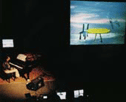
Global Visual Music Project: Goals are to: a) develop software for the creation, mediation, and dissemination of real-time multimedia content, including high resolution two and three dimensional graphics, digital audio and video; b) develop a networking capability for this software, so that multimedia data could be shared between users in many locations; c) organize a high profile event to unveil these resources by staging a networked multiple site public performance with accomplished artists in established artistic and technological venues; d) create a web site to disseminate information about our research; e) freely distribute the software we create; and f) develop and publish a communication protocol for networked distribution of high quality real-time multi-media data.
Posted by jo at 04:05 PM | Comments (0) | TrackBack
November 25, 2004
laptop_orchestra
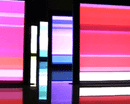
Conducting Synaesthetic Intruments
laptop_orchestra is an interactive synaesthetic instrument designed for performances of audio visual compositions in real time. Fifteen laptops are arranged in rows similar to the formation of an orchestra. Algorithms activate sounds and abstract visual shapes based on the color spectrum; each laptop has its own sound and instructions for the construction of a shape.
Interacting from the orchestra conductor podium by lightly touching metal stems, it is possible to activate or deactivate each laptop, permitting the generation of an endless number of different compositions. Compared to the software of elementary audio and visual compositions, this installation puts the interaction in a defined and public space dimension, drawing a reactive environment in the contour of its physical dimension. Software made with Processing. Download pde file and sound sample.
Limiteazero is an architecture, media design and media art studio based in Milan, Italy.
Limiteazero’s areas of expertise include: network installations design, set design, exhibition design, media in architecture and public space, interaction design, digital identity design, sound design, creative-network-software design.
Limiteazero's experimental activity is concerning the exploration of alternative relations between man, machine and environment, bridging the physical and the digital. It tries to establish an emotional approach using interface systems, instead of a logical/deductive one.
The work around form is mainly focussed on investigating forms and images generated by mathematical processing and through random evolution processes. The "random" sequence is our most used coding expression.
Posted by jo at 12:07 PM | Comments (0) | TrackBack
October 27, 2004
ArtFutura
![]()
Augmented Reality
ArtFutura's theme this year is Augmented Reality. It's taking place now in Barcelona [October 28th-31st]. The programme includes Howard "Smartmobs" Rheingold, Blast Theory who will perform Can You See Me Now?, the SimpleTEXT performance, Dublin’s MediaLab Europe and Montreal’s SAT will be showcasing installations and developing experimental projects, Richard Marks, creator of EYETOY, Greyworld, Fiona Raby, etc. (via)

Saturday October 30, 2004 - 4PM - 8PM, Live from Barcelona, SAT presents Phéromones, the Art Futura's closing show. Phéromones is a network multichannel audiovisual techno performance regrouping musicians Alain Thibault, Physical Noise Theatre & Champion and VJ jocool , Ladyroll & Le couple in Barcelona as well as Yan Breuleux, Nuclear Ramjet & Johnny Ranger in Montreal.
Pheromones will connect by means of an optical fiber network of Internet 2 (providing data flows of up to 2 Gigabytes per second) the Mercat de les Flors at Barcelona and the head office of the SAT at Montreal in order to share music and images generated on both sides of the world, by means of an experimental technical support: eight audio channels and immersive multi-screens. R&D for clubbing culture.
From October 26 to 30, 2004
A team of 17 artists, researchers and technicians, as members of the Territoires ouverts - TOT - Open Territories consortium initiated by the SAT, are invited by the Art Futura festival to present their work in Barcelona.
Several of the tools developed at SAT, like the nSLAM multichannel audio application and pixelTANGO digital video mixer, will be put at contribution in order to show the know-how and the expertise of the developpers in the fields of IP streaming video and mulitichannel audio, IP telepresence (point-to-point and multi-point) and transmission of immersive audio-visual environments over IP networks.
The Open Territories project aims to foster the emergence of innovative forms of cultural expression by engaging the creativity of a new generation of artists and creators, in whose hands will be placed a host of advanced interface and networking technologies. The TOT project will be able to open the broadband network environment to talented creators who are ideally placed to illustrate broadband's potential as a means of avant-garde cultural expression.
Thursday October 28, 2004 - 10AM - 5PM
Friday October 29, 2004 - 10AM - 5PM
Saturday October 30, 2004 - 10AM - 4PM
SAT invites you and your friends to "cross the Atlantic" and project yourself at the beautiful Mercat de les Flors in Barcelona, site of the Art Futura Festival.
During the three days of the festival, using two Telepresence stations, people at both side of the Atlantic will be able to meet and speak as if they were sitting on the same table, with high audio and video resolution.
To participate and meet the catalan artistic community, Art Futura's visitors and the SAT team in Barcelone, come at the SAT Café each day between 10AM and 5PM (4PM Saturday).
Free entrance
Posted by jo at 02:00 PM | Comments (0) | TrackBack
October 12, 2004
Glimmer
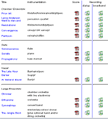
Scores of Light
Glimmer, by Jason Freeman, engages the concert audience as musical collaborators who do not just listen to the performance but actively shape it. Each audience member is given a battery-operated light stick which he or she turns on and off over the course of the piece. Computer software analyzes live video of the audience and sends instructions to each musician via multi-colored lights mounted on each player’s stand. The piece draws from a long history of interactive music, art, and cinema, but it also engages in current issues regarding the use of technology within orchestral concerts. Many orchestras are currently experimenting with interactive handheld devices and large video displays which attempt to explain the music being performed. But many such devices ultimately create barriers to engaged listening. Glimmer challenges audiences to become active collaborators in the live performance, rather than reinforcing their traditionally passive role. The American Composers Orchestra will perform Glimmer in its world premiere on Friday, January 21st, 2005, 7:30 p.m. at Zankel Hall at Carnegie Hall (New York).
The audience is divided into seven groups, each of which is linked to a group of three or four musicians in the orchestra. The percentage of audience members in a group with their light sticks turned on directly affects the dynamics, timbre, and tempo of the corresponding group of musicians. Additionally, a comparative analysis of audience groups regulates pitch choices, texture, and the overall prominence of each group within the orchestra. The more an audience group changes its lights, the more varied and prominent the music played by the corresponding musicians.
Musicians do not perform from a linear score in conventional musical notation. Instead, they respond to the light on their stand according to a series of instructions printed in their part. Different color families indicate which notes to play, the brightness of those colors indicate dynamics, and pulsations and flashes indicate rhythm and accents. Each player’s light is independently controlled directly by computer software. There is no conductor.
Glimmer is realized using off-the-shelf video equipment, DMX-controlled LED lighting, novelty battery-operated light sticks, and custom computer software written for Cycling ‘74’s Max/MSP/Jitter environment.
Glimmer was commissioned by the American Composers Orchestra, Steven Sloane, music director, Robert Beaser, artistic director, Dennis Russell Davies, conductor laureate.
Posted by jo at 09:37 AM | Comments (0) | TrackBack
October 06, 2004
Organised Sound: An International Journal of Music and Technology

Networked Music
Interconnection has always been a fundamental principle of music, prompting experimental artists to explore the implications of linking their computers together long before the Internet reached the public consciousness. As the Internet achieved critical mass over the past decade, networking technology took centre stage as the key to a vast new territory of possibility, facilitating remote participation, distributed processing, and redefinition of musical space and time. The Web emerged as a virtual venue for countless musical purposes, and as analog acoustics transformed to digital representations, packets of data carried by IP from one address to another became a modern metaphor for air molecules transmitting the tone of vibrating body to eardrum.
As with any new technology, applications of networking to music have evolved from naïve proofs-of-concept to more sophisticated projects, and we stand now at a point when 'internetworking' is taken for granted, novelty is expiring and artistic goals more often transcend technical considerations. From this vantage, the essential question is not how networking and music are combined, but why. What is the unique experience that can be created? Whose role can be empowered or transformed: composer, performer, audience? Where can sound come alive that it couldn't otherwise? Networked music can reinterpret traditional perspectives on stagecraft, ensemble, improvisation, instrumentation, and collaboration, or enable otherwise impractical relationships between controllers, sensors, processors, inputs, and outputs. The network can be an interface, a medium, an amplifier, a microphone, a mirror, a conduit, a cloud, or a heartbeat.
The network is all of us. Music is the sound we make. Listen...
Call for Articles and Works
Volume 10, Number 3
Issue thematic title: Networked Music
Date of Publication: December 2005
Publishers: Cambridge University Press
We invite submissions from composers, performers, artists and researchers working in the realm of digital media and sound. Submissions related to the theme are encouraged; however, those that fall outside the scope of this theme are always welcome.
Issue Co-ordinators: Margaret Schedel [gem at schedel.net] and John P. Young [sound at netmuse.org]. This issue is being prepared in collaboration with the International Computer Music Association (ICMA).
The theme represents many avenues for discussion including, but not limited to:
Networked control interfaces (hardware/software)
Sensor arrays/interaction
Distributed/remote participation (composition, performance, reception)
Broadcasting/multicasting/streaming media
Virtual musical environments/venues
Aesthetics/philosophy of musical interconnection
Web-based music projects
OpenSoundControl
Distance learning/education
Online collaboration
Networked data sonification
Real-time remote sensing
Distributed processing
Networking for fault tolerance
Musical avatars/agents/bots
Emergent network phenomena/effects/behavior
Neural networks
Internet2
Alternative musical networks (RF, MIDI, WiFi, Bluetooth, etc.)
Strategies for mitigating network limitations (bandwidth, latency, etc.)
This issue continues the annual partnership between Organised Sound and the International Computer Music Association, with previous themes including "Performing with Technology" and "Collaboration and Intermedia." In exploring these prior areas, networking has emerged as a common element underlying a wide variety of innovative projects, prompting a more focused look at the mutual influence between networks and music. This should be no surprise in the electroacoustic field, where our machines are partners as much as tools, and working with other artists or often even solo requires connection between multiple machines. In the pre-network era, technical obstacles frequently dictated that much computer music occurred in relative isolation, with musicians expending precious attention acting as interpreters between hardware and other humans. So in one sense, networked music can be simply a recapitulation of acoustic music principles, of listening and sensitivity to other performers and audience, by enabling computers to participate equally in the musical conversation. Networking can also radically alter these traditional principles, most obviously by decoupling the spatial framework, enabling some or all of the participants to act and perceive without being physically present. Thus networked music is fertile territory for the composers, performers, and researchers that comprise the ICMA as both a potential means of overcoming challenging limitations of technology, as well as presenting new possibilities we have yet to imagine.
Submissions may consist of papers, with optional supporting short compositions or excerpts, audio-visual documentation of performances and/or other aspects related to your submission. Supporting audio and audio-visual material will be presented as art of the journal's annual DVD-ROM which will appear with issue 10/3. Related discussion will be located on the ICMA Array website, and additional multimedia at Organised Sound's Cambridge University Press website.
SUBMISSION DEADLINE: 1 March 2005
SUBMISSION FORMAT
Notes for Contributors and further details can be obtained from the inside back cover of published issues of Organised Sound or from:
http://uk.cambridge.org/journals/oso/
Email submissions should be sent to (please see SUBMISSION FORMAT above): os at dmu.ac.uk
Hard copy of articles (only when requested) and other material (e.g., images, sound and audio-visual files, etc.) should be submitted to:
Prof. Leigh Landy
Organised Sound
Clephan Building
De Montfort University
Leicester LE1 9BH, UK.
Editor: Leigh Landy
Associate Editors: Ross Kirk and Richard Orton
Regional Editors: Joel Chadabe, Kenneth Fields, Eduardo Miranda, Jøran
Rudi, Barry Truax, Ian Whalley, David Worrall
ICMA Representative: Mary Simoni
International Editorial Board: Marc Battier, Laurant Bayle, Hannah Bosma, Allesandro Cipriani, Simon Emmerson, Rajmil Fischman, David Howard, Rosemary Mountain, Tony Myatt, Jean-Claude Risset, Francis Rumsey
Posted by jo at 09:27 AM | Comments (0) | TrackBack
September 07, 2004
Weather Report
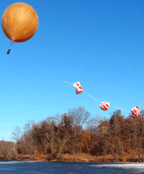
Drifting Voicemail, Found Sounds Stories
"A simple but clever installation in Tallinn, "Weather Report" by Janek Schaeffer, consisted of helium balloons and an MP3 player/cell phone. Recordings gathered by starting a cell phone call and then sending the phone up into the atmosphere attached to a weather balloon while recording the call on voicemail are remixed with other weather noises, to be played back on the cell phone in the installation." from ISEA 2004: Art Report by scott @ 10:10 pm, 09.05.04.
From Schaeffer's web site: "The weather balloons were used in 3 main ways. Firstly one icy winters morning I attached a mobile phone to receive and send low resolution sound, letting it float away from the surface of a frozen lake. Secondly using a digitaldictaphone I made time lapse recordings of the sky by floating it 500ft above my lush metropolitan neighbourhood. Lastly a few all American friends and I set out to shootthe balloon down late one June afternoon leaving the sound to parachute back to earth. I let the recordings speak for themselves, no effects, no eq, just straight cut & splice collage where you can hear the edges of time. Some other sounds collected include: underwater ice skaters; flapping; old meteorological kit; leaf blowers; repairing weather damage; various 60's archive audio; melting ice, ski across snow, Minnesota forecasts on radio, in the car and on TV; Tornado chasing & test equipment; snow flakes landing on mic; squeaky tree; National Weather Service balloon launch; walkie talkie tones from my Science Museum workshop etc. Oh, and all temperatures in Farenheight...
The result is a highly compressed Found Sound story, heard as a drifting voicemail message from the weather balloon. A hybrid documentary collected and edited outdoors, where it is designed to be heard walking with headphones... so.. go find a Walkman!"
Posted by jo at 10:25 AM | Comments (1)
September 04, 2004
Work by Don Ritter
Physical Aesthetics
"Unlike art from previous times, interactive art considers the viewer’s body as an integral component of the experience; the quality of this experience is measured by the term physical aesthetics, being the pleasantness or unpleasantness of the physical experience involved with the control of an interactive experience. The involvement of a viewer in an artwork could be viewed as being more democratic than the autocratic experiences presented by older art forms." Read the full interview.
![]()
Vox Populi endows anyone with leadership, regardless of their personal wealth, family origins, or political connections. A video projected crowd chants "speech, speech" and encourages visitors to speak from a lectern. When a visitor speaks through the microphone, the voice is amplified and political speeches begin scrolling on a teleprompter located within the lectern. In response to a speaker’s voice, the crowd reacts with varying degrees of support and repulsion.
Other works by Don Ritter (Real movies available on site):
The Technophobe and the Madman: Internet-2 distributed musical
telecommunications video-music performance, 2001; 12 channels audio and 6 channels full screen video connection between Frederick Loewe Theatre, New York City and iEAR Studio, Troy, New York; collaborative performance: performers share audio and video between 2 cities.
Performance Telematique: Interactive telecommunications performance between two cities, 1993; PictureTel system, two channels full screen video and two channels audio Obscure, Quebec City, and McLuhan Program, University of Toronto, Canada (500 miles, 800 km).
Nervous Orpheus: Interactive telecommunications performance between two cities, 1994; PictureTel system, two channels full screen video and two channels audio; Vancouver and Toronto, Canada (2800 miles, 4500 km).
Posted by jo at 11:34 AM | Comments (0)
September 01, 2004
Observing the net
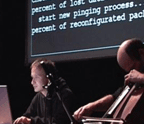
Ping Me a Melody
"Ping Melody is a music-net-performance. Temporary and unique state of all actions of Internet users has an influence on form of music composition. Musician (instrumentalist or singer) is playing on acoustic instrument/singing and sounds coming from instrument/voice are shared in packets of data information (granulated), then transmitted to selected Internet location (as "ping" unix command).
Most of net artists are using some specific possibilities of Internet: they are working with WWW, streaming, etc. In Ping Melody I treat Internet not so much as a tool which functions in given way, but as a space, that can be observed."
Posted by jo at 06:43 PM | Comments (0)
August 20, 2004
Motherboard
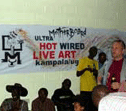
Ultra Hot Wired Live Art
In February 2003 a group of artists from Norway, Germany, Holland, Canada, England and Austria, working together on a project called Ultra Hot Wired Live Art initiated by Motherboard and BEK traveled to Kampala with 15 powerful Macintosh computers in their baggage. The aim was to create African computer art in an attempt to answer Brian Eno's question: "How can you africanize a computer"?
In collaboration with over twenty artists and musicians in Uganda, the artists held a workshop to share competencies in music and art production that utilize digital tools and the Internet. This was to develop a social and technical infrastructure for the creation of networked performances and future collaborations. More info
Posted by jo at 04:10 PM | Comments (0)
August 03, 2004
Lag and Flux as Starting Point
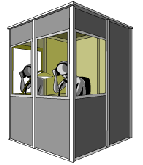
Simultaneous Translation
John Roach is working on a multilocation networked audio performance called Simultaneous Translation which will involve players from USA, Spain, France, Italy and Germany. The first performance is slated for November 2004 in Madrid Spain. Other manifestations are planned for NYC and Trondheim Norway.
"In my first foray into networked performance entitled Negative Space it was the limitations of the streaming media which made the project difficult and exciting. This lag and flux is the starting point of Simultaneous Translation in which the idea of flux and slippage is put in the forefront and is compared to the slippages and mutations of language as it evolves. Another point of comparison is to the delays that occur on the web as data passes from router hop to router hop. In fact traceroute data will be used to manipulate audio streams from the remote participants, making the delay of the internet itself an active player in the project."
Posted by jo at 05:03 PM | Comments (0)
August 01, 2004
Distributed Opera
The BRAIN OPERA
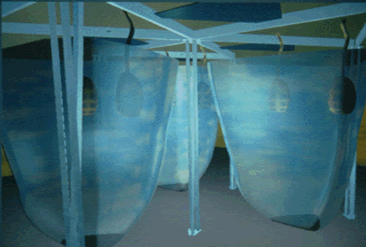
Premiered in 1996, this interactive, musical journey was presented simultaneously in physical and cyber space. A viewer could perform live in the Brain Opera performances via " T h e P a l e t t e," musical instrument. This advanced, multi-user Java applet, was only active during Brain Opera performances. You could also see and hear live video and audio broadcasts of the Brain Opera performances.
The culmination of the Brain Opera experience was the 45-minute Final Performance--a 3-movement composition tied together the project's many musical, visual, and textual strands into a unified tapestry. Three performers shape, select, and interpret precomposed and audience-created elements, using specially-designed hyperinstruments: the Sensor Chair (which translates wireless body movement into sound); the Gesture Wall (a modification of the same instrument from the Mind Forest); and the Digital Baton (which combines pointing, squeezing/selecting, and motion sensing). A large curved screen and multiple projectors allows a constant flow of images to be presented in coordination with the music, illustrating Minsky's words, providing counterpoint to the music, or illuminating the actions of the performers. The audience is also invited to dance on a Sensor Carpet during the Finale, adding sound to the richness and intensity at the end of the work.
Posted by michelle at 04:51 AM | Comments (0)
July 31, 2004
Historically Locating Distributed Performance
2004.04.05 Helen Thorington, writing about an early conference proposal:
The following are examples of distributed performances:
Finding Time (Jesse Gilbert, 2000). Finding Time linked performers on six continents in a series of live musical events, each an hour’s duration.
World Wide Simultaneous Dance (1998, Laura Knott). The project took place simultaneously in twelve countries.
In both examples the performers played to audiences in their performance spaces and to a worldwide Internet audience by means of especially created websites.
I then move on to a brief history, beginning with Kaprow's "Hello Hello" in the mid-60s--about which I can find very little information other than that it linked five sites in a television event. And on to Kit Galloway and Sherri Rabinowitz.
But the history is the not the question for me. Internet works resonate with historical issues. But what I'm beginning to think as I research for the conference is that we may already have witnessed the passing of the (pre)structured presentation of large-scale performance works--I keep thinking, for instance, that while Adrift (1997-2001) was very different from other works produced at its time, it was also very traditional. It was a work by three artists (the senders), in which its audiences had no agency at all--Like radio, like television, they were cast in the role of "receivers."

From the Adrift performance
Now...when did it happen?...the Internet environment is in a far more participatory stage and people-interest runs to works/platforms/
environments in which the former viewer can play an active role. Which may begin to explain why there are really not very many interesting large performance works being produced at this time. Not only is the technology still difficult but the environment is no longer congenial.
Or am I wrong? And if not, what does this do for/to our conference?
I'm going to think about this for awhile. Right now my only thought is that if this is so, the conference itself should reflect it and include the many twists and turns performance has taken in the last years.
Posted by michelle at 01:22 PM | Comments (0)

